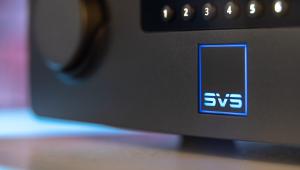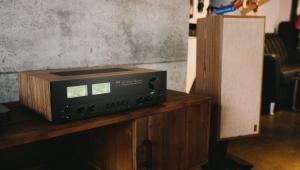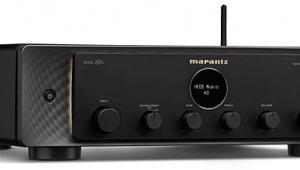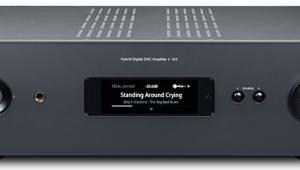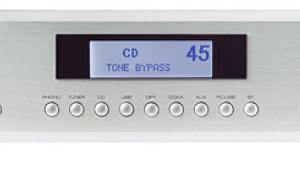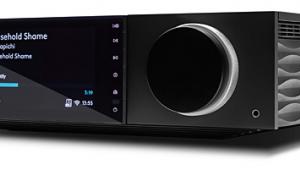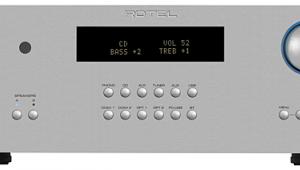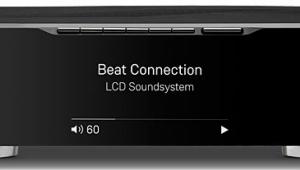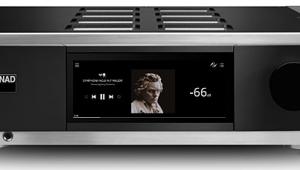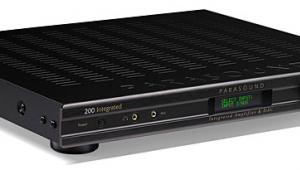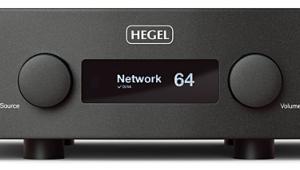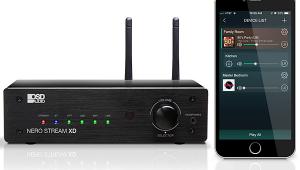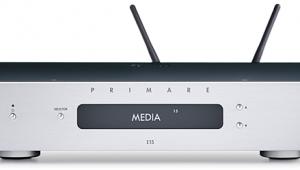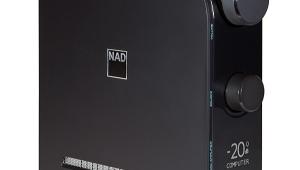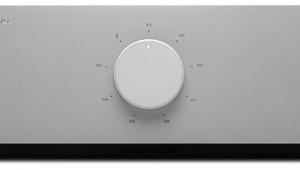NAD Masters M33 Streaming Integrated Amplifier Review Page 2
I mostly used my iPhone 6S as my BluOS controller. This for the most part worked fine, though I did have to reboot the M33 once, and the app a few times. To integrate my local music library, which resides on an external terabyte drive connected to my iMac via USB, I had to point BluOS manually to my music folder's exact network "share" name by carefully typing it in as \\computer\drive\music. There's a browse-to-find search function for Windows, but not for Mac OSX—apparently, mom still loves Big Blue best. But this worked fine, initially, and I quickly was streaming my local hi-res library.
 Initially. After a routine reboot of my iMac, my "shares" had disappeared from BluOS, and hours spent trying to re-enter them failed to bear fruit. Finally, after descending to the "try-random-anything" circle of frustration, I switched my iPhone from my router's 2.4 GHz Wi-Fi network to its 5 GHz band, and—bingo!—the shares could be manually entered as before. (This despite the fact that the iMac is networked via wired Ethernet, with its own Wi-Fi off, and that after the reboot BluOS still had dutifully streamed Qobuz over the 2.4-gig band.) Welcome to the 21st century! This sort of network-connect arbitrariness, while far from unique to NAD's latest, is obviously annoying, and bound to cost the company many a help-desk hour.
Initially. After a routine reboot of my iMac, my "shares" had disappeared from BluOS, and hours spent trying to re-enter them failed to bear fruit. Finally, after descending to the "try-random-anything" circle of frustration, I switched my iPhone from my router's 2.4 GHz Wi-Fi network to its 5 GHz band, and—bingo!—the shares could be manually entered as before. (This despite the fact that the iMac is networked via wired Ethernet, with its own Wi-Fi off, and that after the reboot BluOS still had dutifully streamed Qobuz over the 2.4-gig band.) Welcome to the 21st century! This sort of network-connect arbitrariness, while far from unique to NAD's latest, is obviously annoying, and bound to cost the company many a help-desk hour.
Listening
The M33 proved utterly devoid of any sonic shortcomings, producing all the clean, dynamic, perfectly detailed power I could use (and a good deal more), and with all the depth and detail that comes from technically transparent D-to-A processing and outstanding dynamic range.
My Energy Veritas 2.2i stand- mount three-ways doubtless now qualify as "vintage" audio, yet they remain competitive with the best dynamic speakers available. (Not too long ago I replaced both midrange/ tweeter modules with factory- packaged, new-old-stock units I found in Canada: score!) These very capable speakers have the added virtue of being, while relatively benign loads in phase-angle terms, singularly low in real-world sensitivity, which means I can wring out even a very substantial amplifier like the NAD without risking hearing loss.
My first stop was Donald Fagen's "Morph the Cat" from the eponymous album (24-bit/96kHz FLAC), which has become a favorite "wet-read" for overall performance thanks to its prodigious deep bass and super-dynamic, crystalline transient content. The M33 had no difficulty whatsoever playing this at studio-control-room- levels, with sound quality as fine as I've heard from my Energy speakers: detailed, crisp, and very punchy without the least hint of telltale sibilance on transient leading edges that would suggest incipient clipping.
Listening at slightly more civilized levels proved equally enlightening. A classic Decca recording of Radu Lupu playing the Schubert "Impromptus" (24/96 FLAC, Qobuz) is recorded very cleanly and dynamically from the "page- turner's perspective," i.e., as if the listener is sitting on the bench next to the pianist. The result was pristine, whether on Lupu's sub-whisper pianissis- simos, or the maximum output of the big Steinway. Well-recorded concert-grand piano sound is ruthlessly unforgiving, and there was nothing to forgive. The "ping," "pop," and air-compressing wave-front of big attacks were all there, while decaying notes faded into perfect black silences. Wrapping it all together was a marvelously naturalistic recording (and reading) of Beethoven's Seventh by the Minnesota Orchestra under Finnish conductor Osmo Vänskä on BIS (24/96 FLAC, Qobuz). Here, the full depth of the space, without any exaggerated reverberation or microphone- magic highlighting, and the full, honest dynamics of a classical orchestra heard from fairly close in were beautifully rendered when played at lifelike levels.
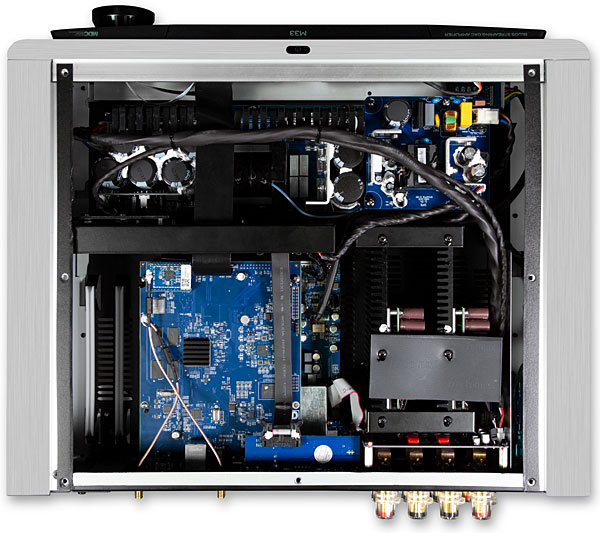
Jazz was no challenge for the M33, either. A track like "Up Jumped Spring" from the Christian McBride Big Band's For Jimmy, Wes, and Oliver (24/96 FLAC, Qobuz) presented Quincy Phillips' delicate snare brushwork and minimalist cymbal accents with natural stunning realism but no "extra" sizzle or sheen, while the great Joey DeFrancesco's Hammond B3 lines revealed all their natural leading-edge "puff" and subtle interior grit. And McBride's bass solo on this track had real density on its one really low note, and convincingly woody, fingerboard-damped realism on all the rest. The next track, "Milestones," features a full-band intro with brass ensemble dynamics that retained full definition and detail. This sounded as it should: like a gathering of individuals, not like canned "brass" playback. When a superb recording like this one, close in and relatively dry without the added "audiophile sauce" of ample hall-sound (or digitally retrofitted reverb), raises goosebumps, you know you're hearing the real deal.
In short, sonics-wise, no complaints. None.
This, however, is only the visible (or audible) part of the M33's sonic iceberg, because, well: Dirac. Dirac Live, the NAD's onboard room/speaker-EQ correction system, is a sort of European equivalent of Audyssey. Unlike Audyssey, or most of the proprietary, no-doubt cheaper and in my opinion mostly inferior systems now found in major-brand AVRs, Dirac requires an outboard PC or Mac computer or iOS/ Android device for measurement and processing to take place.
The M33's Dirac Live is a sort of "Lite" version that measures and corrects only up to 500 Hz, which nonetheless covers most of the heavy lifting that any such system can offer. (Above the "transition frequency" where room modes cease to exert much influence— typically a few hundred Hz—equalization becomes much more of a crap- shoot that's highly dependent on speaker radiation patterns, placement, and room surfaces and furnishings.) M33 owners can upgrade to full-bandwidth Dirac Live Full Frequency for an up-charge of $99 via a card supplied with the unit.
I ran the M33's Dirac using the supplied "puck" micro- phone, conveniently via my iPad Mini 5 and Dirac's relatively new iOS app, with no difficulty. It's an elegant system, but since Dirac has been amply covered in these pages by myself and others I will not rehearse the process here fully, other than to point out that the M33's iteration permits storage and recall of up to five different correction "runs," for different speakers, placements, or seating positions. My measurement run for a single-listener setup required nine mic positions in concentric rings around the primary seating area, with the whole process taking 15 minutes. Unlike most receiver-bound correction systems, Dirac Live permits the user to adjust the target curve, shaping response to the listener's room, speakers, or preference, though—unless one upgrades to Full Frequency—only over the bottom four-plus octaves.
In my system the results were familiar: "tighter," more lifelike bass, with better "focus" thanks to mitigation of my room's principal mode's 60-90 Hz dip/peak. This, in consequence, made everything sound, well, not "cleaner" per se, but more dimensional and present. As I've observed before, getting the bass right makes a real, tangible difference over the full range of any system.
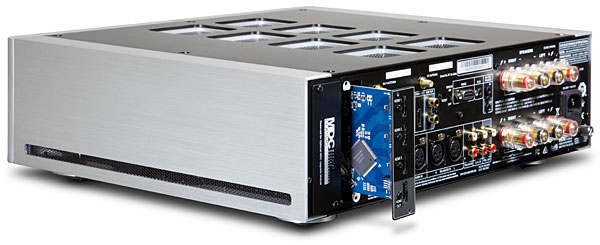
Ergonomics
A few final notes on the M33's ergonomics before I wrap up. Using the BluOS app, I was disappointed to find that my iPhone's volume buttons did not command the currently playing source—the M33 in this case. Having to navigate to the "now playing" screen, at least a swipe or two away and sometimes three or four, just to adjust or mute volume, was a pain. Overall, though, I liked the latest BluOS, and found it clearly more stable than the early version I used a few years back.
AirPlay 2 from my iMac sometimes worked, and sometimes would switch over and play for a few seconds only to then mute and refuse to resume or reconnect. (The same content and source applications AirPlay-ed just fine to my Onkyo pre-pro.) Then, the next day, with nothing changed, AirPlay worked fine. The M33's front-panel display, though stunning, is not terribly useful as a touch-panel unless it's eye-level at the listening position (working it while standing above is awkward), which seems unlikely. And while the M33's option to display dancing VU meters—your choice of "digital" (bar) or "analog" (needle)—is visually very cool, these virtual meters are immovably placed in the signal-path upstream of both the power amps and the volume control, so regardless of volume setting (or speaker load) their action remains the same.
Conclusion
NAD's new M33 Masters Series streaming integrated amplifier leaves me mute. Stunning sonics, gob-smacking good looks, and great value. Value, in a $5,000 component? True, for five large or likely a bit less you could assemble a separate streamer, wireless controller, and Purifi-based power amplifier of equivalent performance, but doing so would entail vastly greater complication, cabling, clutter, and inelegance. Over the years, only a few products have passed through my door that I would eagerly spend my own money on. NAD's M33 is one of them.

